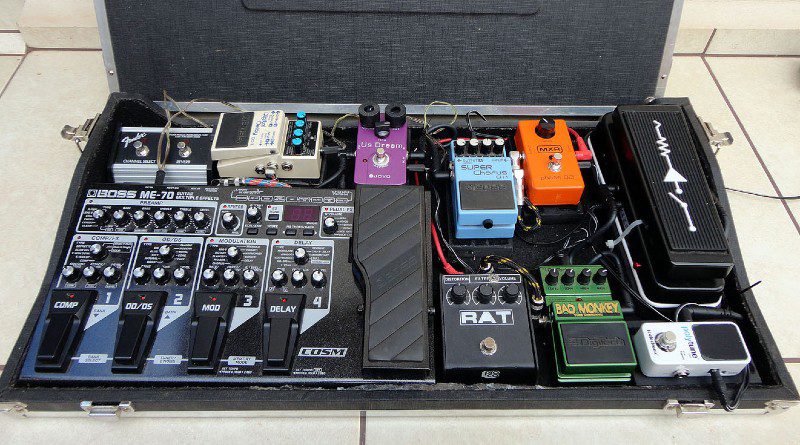In a pedalboard, the compressor unit generally goes after a wah pedal. While it is, of course, a matter of preference, putting the compressor first will limit the range, function, and dynamics of the wah pedal. The result will be arguably less musical and pleasing overall.
Guitarists today are spoiled for choice. The market offers more effects, amplifiers, and all-around noisemakers than anyone could imagine in the 70s and 80s. If you think about how affordable and accessible music gear is, this really feels like the golden age of tone sculpting.
When it comes to effect signal chain, pedal placement is a recurring topic that has sparked a lot of debate. Building your pedalboard and deciding your signal chain is as much a science as it is an art. And, when the two meet, experimentation is always welcome.
However, there are some tried and tested ideas that function as a starting point, and we’ll walk you through the ins and outs of comps, wah, and pedalboard placement.
Contents
Guitar Compressor Pedals: An Overview
Compression is a part of the “dynamics” – it influences the dynamic range. The Xotic SP and Cali76 Deluxe are some of our favorite compressor pedals. Though classically used on clean guitar signals in country, blues, and funk, they enjoy all-pervading popularity across styles and genres.
Anything that goes after a compressor is also going to get controlled in the process. For instance, if you place an OD before a compressor it will boost the overdriven signal, and if you place the OD after the compressor, the signal will sound more compressed (and you have to be aware of where you put your EQ in that chain too as they tend to add noise).
For this reason, they are generally placed at the beginning of the effects signal chain. Understanding what goes after and before a compressor and how it influences the tone is important.
Guitar Wah Pedals: An Overview
A Guitar wah-wah (or simply wah) pedal could refer to a wah pedal like the Classic Dunlop Cry Baby or any auto-wah / envelope filter pedal like the T-Rex Tonebug or Boss AW-3. They are commonly used in funk, blues, rock, and metal.
Like compressors, wah pedals are also categorized as “dynamic” pedals. They are tone filters or envelope filters that dynamically respond to the attack with a spectral glide. Conventionally, a wah pedal will retain more dynamic character right at the beginning of your signal effect chain.
They invariably feature first – right at the start of a chain. Harmonizers and/or pitch shifters are the only pedals that are commonly placed before them.
Can I place a compressor AFTER wah?
Place a compressor after the wah if you want to level off the peaks – the occasional spikes of the filter sweep when you dig in too hard. The compressor-after approach will make the wah pop with a more pronounced vocal quality.
The compressor also acts as a pseudo limiter and tames the strident sounds in the upper range of the sweep. Unlike an actual limiter pedal, it won’t influence the playing dynamics of a wah. In simple words, a wah before a compressor makes it sound more “wah-wah” than “wonk-wonk”.
The “wah first” is the most commonly used placement formula. However, since compressors are more commonly used than wah, you’ll probably hear the same thing as the pedalboard mantra: compressor first, except after a wah.
Can I place a compressor BEFORE a wah?
Wah pedals are highly influenced by your playing dynamics. If you place a compressor before them, it adversely limits the dynamics, which in turn limits their response and performance. However, there are situations where a comp to wah would sound better.
However, this will rarely work with a “vintage” sounding wah because any buffer in the line will rob them of their warmth. Most of the comp-to-wah scenarios are built on artistic preference or the compressor’s “tone coloration” abetting the unconventional placement.
There are two ways to use a wah: To have it on (pedal it in) and use the playing hand to control the filter, or b) use the foot to rock it back and forth to manipulate the tone. If you are rocking it with your foot, you’ll find it sounds better when first in the chain.
Conclusion: WAH FIRST
In most cases, a compressor pedal before a wah will impede its function by decreasing the range of the original signal, especially if heavy compression is involved. Moreover, if you depend on the filter’s expressiveness to influence your distorted tone, that will also sound relatively meek.
Nevertheless, tones are subjective and there are always mavericks who will create oomph from the most unheard-of combinations. So, neither is considered right or wrong if you can say “that’s exactly what I was going for” in the end.
Does the order really matter in a pedalboard?
That would be an emphatic yes. In every pedalboard, the order is paramount because the signal will be processed multiple times as it travels through the pedals. There are some general guidelines to keep in mind as you set up your effect signal chain:
- Tuner (with buffer or true bypass)
- “Dynamics”: Wah, Compressors, Volume Pedals, and others.
- “Gain”: Overdrive, distortion, and boost pedals.
- Modulation: Flanger, Phaser, Chorus, Univibe, and others.
- “Time” – Delay, Reverb
Final Thoughts
As you experiment with placement, you will find the sweet spots, sometimes conventional and at other times not. Over time, you’ll find the ideal way to daisy-chain effect pedals and rack gear to sculpt the tone of your dreams.
Title image courtesy of Marcelodonati on Flickr.

